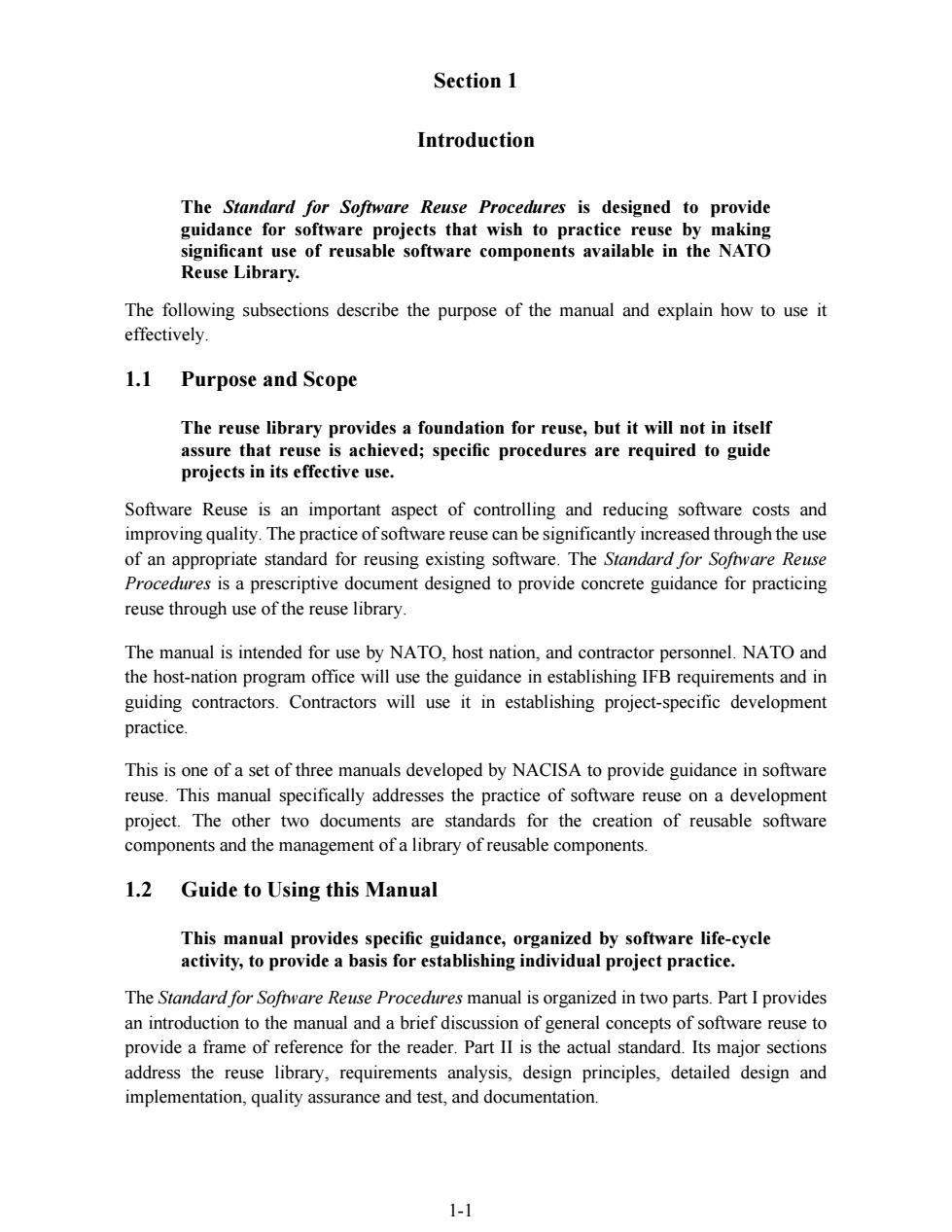正在加载图片...

Section 1 Introduction The Standard for Software Reuse Procedures is designed to provide guidance for software projects that wish to practice reuse by making significant use of reusable software components available in the NATO Reuse Library. The following subsections describe the purpose of the manual and explain how to use it effectively. 1.1 Purpose and Scope The reuse library provides a foundation for reuse,but it will not in itself assure that reuse is achieved;specific procedures are required to guide projects in its effective use. Software Reuse is an important aspect of controlling and reducing software costs and improving quality.The practice of software reuse can be significantly increased through the use of an appropriate standard for reusing existing software.The Standard for Sofiware Reuse Procedures is a prescriptive document designed to provide concrete guidance for practicing reuse through use of the reuse library. The manual is intended for use by NATO,host nation,and contractor personnel.NATO and the host-nation program office will use the guidance in establishing IFB requirements and in guiding contractors.Contractors will use it in establishing project-specific development practice. This is one of a set of three manuals developed by NACISA to provide guidance in software reuse.This manual specifically addresses the practice of software reuse on a development project.The other two documents are standards for the creation of reusable software components and the management of a library of reusable components. 1.2 Guide to Using this Manual This manual provides specific guidance,organized by software life-cycle activity,to provide a basis for establishing individual project practice. The Standard for Software Reuse Procedures manual is organized in two parts.Part I provides an introduction to the manual and a brief discussion of general concepts of software reuse to provide a frame of reference for the reader.Part II is the actual standard.Its major sections address the reuse library,requirements analysis.design principles.detailed design and implementation,quality assurance and test,and documentation. 111-1 Section 1 Introduction The Standard for Software Reuse Procedures is designed to provide guidance for software projects that wish to practice reuse by making significant use of reusable software components available in the NATO Reuse Library. The following subsections describe the purpose of the manual and explain how to use it effectively. 1.1 Purpose and Scope The reuse library provides a foundation for reuse, but it will not in itself assure that reuse is achieved; specific procedures are required to guide projects in its effective use. Software Reuse is an important aspect of controlling and reducing software costs and improving quality. The practice of software reuse can be significantly increased through the use of an appropriate standard for reusing existing software. The Standard for Software Reuse Procedures is a prescriptive document designed to provide concrete guidance for practicing reuse through use of the reuse library. The manual is intended for use by NATO, host nation, and contractor personnel. NATO and the host-nation program office will use the guidance in establishing IFB requirements and in guiding contractors. Contractors will use it in establishing project-specific development practice. This is one of a set of three manuals developed by NACISA to provide guidance in software reuse. This manual specifically addresses the practice of software reuse on a development project. The other two documents are standards for the creation of reusable software components and the management of a library of reusable components. 1.2 Guide to Using this Manual This manual provides specific guidance, organized by software life-cycle activity, to provide a basis for establishing individual project practice. The Standard for Software Reuse Procedures manual is organized in two parts. Part I provides an introduction to the manual and a brief discussion of general concepts of software reuse to provide a frame of reference for the reader. Part II is the actual standard. Its major sections address the reuse library, requirements analysis, design principles, detailed design and implementation, quality assurance and test, and documentation